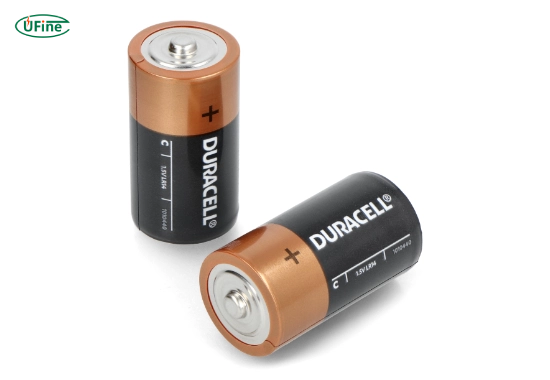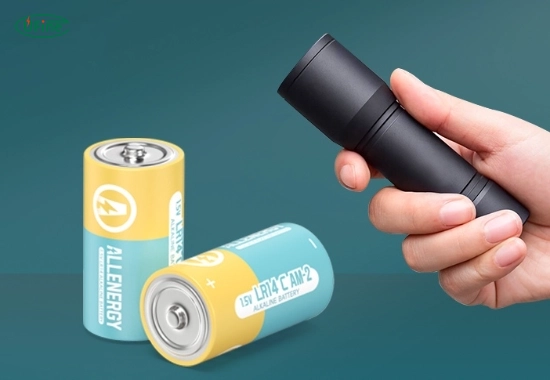
- Part 1. What is an LR14 battery?
- Part 2. Technical specifications of an LR14 battery
- Part 3. Common applications of LR14 batteries
- Part 4. How long does an LR14 battery last?
- Part 5. Are LR14 and C batteries the same?
- Part 6. Can LR14 batteries be recharged?
- Part 7. Comparison chart of LR14, R14, and HR14 batteries
- Part 8. How to identify an LR14 battery
- Part 9. Safety tips for handling LR14 batteries
- Part 10. How to choose the right LR14 battery brand
- Part 11. FAQs about LR14 batteries
If you’re searching for information about the LR14 battery, you’re likely trying to understand what this battery does, how it compares to similar types, and where it is used. The LR14 battery, often called a C battery, is a medium-sized power cell commonly found in electronic devices. It delivers reliable performance, making it a go-to choice for items that require steady energy over time.
This guide explores everything you need about the LR14 battery, including its specifications, chemistry, usage, lifespan, comparisons with other battery types, and more. Whether replacing batteries in a device or just trying to learn more, this article will give you a complete picture of how the LR14 battery works and what makes it different.
Part 1. What is an LR14 battery?
An LR14 battery is a non-rechargeable alkaline battery in the C-size category. The “LR” indicates the alkaline manganese dioxide chemistry used in the cell, while “14” is the size code based on IEC (International Electrotechnical Commission) standards. It provides a nominal voltage of 1.5 volts and is designed for devices that require moderate but consistent power output.
The LR14 is widely used in portable electronics such as flashlights, battery-powered toys, radios, and medical instruments. It offers a longer shelf life and more stable energy delivery than lower-grade battery alternatives like zinc-carbon cells.
Part 2. Technical specifications of an LR14 battery
The LR14 battery has standardized dimensions and electrical characteristics that make it suitable for various devices. Below are its core technical specifications:
- Size: C (IEC code: LR14)
- Nominal Voltage: 1.5V
- Chemistry: Alkaline manganese dioxide
- Diameter: 26.2 mm (1.03 inches)
- Height: 50 mm (1.97 inches)
- Terminal type: Flat negative base, raised positive button top
- Typical Capacity: 6,000–8,000 mAh (depending on brand and usage pattern)
- Weight: Approximately 65–75 grams
- Operating Temperature: -18°C to 55°C
- Shelf Life: Up to 10 years
These batteries are built to offer steady current flow, making them ideal for equipment that needs consistent performance without frequent power drops.
Part 3. Common applications of LR14 batteries
The LR14 battery is widely used in both consumer and professional applications. Because of its size and capacity, it is ideal for medium-drain devices. Here are some of the most frequent uses:
- Flashlights: Offers bright, long-lasting light
- Toys: Power battery-operated toys like RC cars and talking dolls
- Radios: Suitable for AM/FM radios and portable stereos
- Medical devices: Used in equipment like blood pressure monitors and thermometers
- Electric toothbrushes: Provide steady energy for vibration motors
- Clocks and timers: Long shelf life supports low-drain applications
- Camping gear: Power lanterns and emergency beacons
Its versatility makes the LR14 a reliable power source for both indoor and outdoor electronics.
Part 4. How long does an LR14 battery last?
The lifespan of an LR14 battery depends on how it is used. Different devices require different levels of energy, which affects its lifespan.
Typical usage scenarios and estimated lifespan:
- Low-drain devices (e.g., wall clocks): 6 months to over 1 year
- Moderate-drain devices (e.g., radios): 20–60 hours of continuous use
- High-drain devices (e.g., toys, flashlights): 5–20 hours, depending on intensity
Environmental conditions such as temperature and humidity also influence battery performance. For best results, store LR14 batteries in a cool, dry location and avoid mixing old and new batteries in the same device.
Part 5. Are LR14 and C batteries the same?
Yes, LR14 batteries are a type of C battery, but not all C batteries are LR14. “C battery” refers to the size, while “LR14” specifies the chemistry and type.
Here’s a breakdown:
- C battery: Generic size term, can include different chemistries
- LR14 battery: Alkaline chemistry, 1.5V, non-rechargeable
- R14 battery: Zinc-carbon chemistry, lower capacity
- HR14 battery: Rechargeable nickel-metal hydride (NiMH)
- CR14 battery: Lithium chemistry, higher voltage, less common
Always check the label and chemistry to ensure compatibility with your device. Some electronics may specifically require alkaline batteries like the LR14 for optimal performance.
Part 6. Can LR14 batteries be recharged?
No, LR14 batteries are not rechargeable. They are designed for single use only. Attempting to recharge an LR14 battery can result in:
- Leakage of corrosive materials
- Swelling or rupture of the battery casing
- Short circuits or fire hazards
Look for HR14 (NiMH) batteries if you need a rechargeable alternative. These are designed for multiple charging cycles and offer similar dimensions, although they often have a slightly lower voltage (1.2V).
Part 7. Comparison chart of LR14, R14, and HR14 batteries
To better understand the differences between these battery types, here is a comparison chart based on real-world data and manufacturer specifications:
| Feature | LR14 (Alkaline) | R14 (Zinc-Carbon) | HR14 (NiMH Rechargeable) |
|---|---|---|---|
| Chemistry | Alkaline Manganese | Zinc-Carbon | Nickel-Metal Hydride |
| Nominal Voltage | 1.5V | 1.5V | 1.2V |
| Rechargeable | No | No | Yes |
| Typical Capacity | 6,000–8,000 mAh | 2,000–3,000 mAh | 2,200–4,000 mAh |
| Shelf Life | Up to 10 years | 2–3 years | 2–5 years (with recharge) |
| Operating Temp. Range | -18°C to 55°C | 0°C to 45°C | 0°C to 45°C |
| Price per Unit | Moderate | Low | High (initial cost) |
| Ideal For | Flashlights, toys, radios | Clocks, remote controls | Daily-use electronics |
| Environmental Impact | Medium | High | Low (reusable) |
This chart shows that while LR14 batteries offer higher capacity and longer shelf life, HR14 batteries are more sustainable over time due to their rechargeable nature.
Part 8. How to identify an LR14 battery
To identify an LR14 battery, check the labeling on the battery casing. It is often marked with one or more of the following designations:
- LR14
- C
- MN1400
- AM2
- E93
These labels refer to the same size and voltage. It is a compatible match if your device manual specifies “C” batteries, and you see “LR14” on the packaging or battery.
Part 9. Safety tips for handling LR14 batteries
Using LR14 batteries safely ensures better performance and longevity for both the battery and the device. Here are essential safety practices:
- Insert correctly: Match the positive and negative terminals to the device markings.
- Avoid mixing: Don’t use new and old batteries together.
- Store properly: Keep in a dry, room-temperature area.
- Keep away from children: Batteries pose a choking and chemical hazard.
- Recycle responsibly: Do not throw batteries into the regular trash. Use a certified recycling center.
Following these precautions helps prevent leakage, overheating, and accidental damage.
Part 10. How to choose the right LR14 battery brand
Not all LR14 batteries are created equal. Some brands offer better power output and longer shelf life than others. Here are some of the most trusted LR14 battery brands:
- Duracell: Known for high energy density and long shelf life
- Energizer: Offers stable performance and a leak-resistant design
- Panasonic: Reliable power for industrial and consumer needs
- Varta: German-engineered, suitable for high-drain devices
- Amazon Basics: Great balance between price and performance
Choose a brand based on your usage. For critical devices, go with premium brands. Budget brands work just fine for occasional-use gadgets.
Part 11. FAQs about LR14 batteries
Can I use an LR14 battery in place of a C battery?
Yes. An LR14 battery is a type of C battery with alkaline chemistry. As long as the device supports alkaline 1.5V cells, it will work perfectly.
What is the shelf life of an LR14 battery?
Most LR14 batteries can last up to 10 years when stored in a dry, calm environment. Always check the expiration date on the packaging.
Is it safe to use LR14 batteries in outdoor equipment?
Yes, LR14 batteries are designed to function in a wide temperature range, making them suitable for outdoor gear like flashlights and lanterns.
Can I replace a rechargeable HR14 battery with an LR14?
Technically, yes, but be cautious. Some devices are designed for the slightly lower 1.2V of HR14. Replacing with 1.5V alkaline LR14 might affect performance or lifespan.
Are LR14 batteries environmentally friendly?
They are more eco-friendly than zinc-carbon types but less so than NiMH rechargeable batteries. Always recycle used batteries properly.
Related Tags:
More Articles

1.5V Battery Vs. 1.2V Battery: Comparison of Their Differences
Compare 1.2V vs 1.5V batteries: voltage, usage, rechargeability. Best for remotes, toys, cameras. Discover which AA battery suits your device.
Recommended 10 Best Batteries For Smoke Detectors
Discover the best batteries for smoke detectors in 2025. Compare top 10 9V and AA options for long-lasting, leak-proof, and reliable smoke alarm power.
Triple A Battery Voltage: Everything You Need to Know
Learn how many volts are in a triple A battery (1.5V vs 1.2V), see AAA battery voltage chart, and compare chemistry, testing, and lifespan for 2025 devices.
9V vs AA Batteries for Fire Alarm: Which One Should You Use?
Compare 9V and AA batteries for smoke detectors. Learn which type provides better lifespan, voltage, and cost efficiency to keep your fire alarms reliable.
Flashlight Battery Size: Types, Choosing Tips and FAQs
Explore flashlight battery sizes with an easy chart. Learn what batteries small flashlights use and how to pick 18650, 26650, 14500, or CR123A cells.




